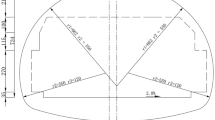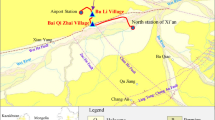Abstract
Currently, there is a strong need for urban tunnels to relieve traffic. Hence, the possibility of tunnels crossing complicated geological conditions is also increasing. The study proposes a new grouting reinforcement countermeasure for loess stratum by means of data investigation, experimental study, and field application. The Yuhan Road underground tunnel is a typical shallow buried loess tunnel with small spacing, with large areas of collapse and leakage accidents during excavation. To reinforce the stratum by grouting, geological research on Jinan loess is performed and a close association of Jinan loess genesis and water is observed. A significant distinguish is observed between Jinan loess and northwestern Chinese loess in terms of origin, structure, particle size composition, and collapsibility. By collecting and comparing the engineering properties of loess, it is found that the regional characteristic of loess is distinct and the engineering particularity, especially severe water sensitivity, of Jinan loess is thus clarified. Because of the caused inapplicability of existing grouting theories and countermeasures, the grouting reinforcement mechanism of Jinan loess is thus studied to clarify the comprehensive impact of water during grouting process. A dynamic grouting control theory is proposed to determine the optimal water-cement ratio (W/C) based on specific stratum water content. On this basis, a multibag hierarchical and sequential grouting countermeasure is proposed to treat a collapsed section on this basis. By means of bags and compacted soil, barriers are formed at the boundaries of the treatment area to make the slurry reinforce the target area on purpose. This countermeasure achieves considerable success in controlling the deformation of the surface and vault, ensuring the completion of construction.












Similar content being viewed by others
References
Akin M, Akkaya İ, Akin MK, Özvan A, Ak Y (2019) Impact of jet-grouting pressure on the strength and deformation characteristics of sandy and clayey soils in the compression zone. KSCE J Civ Eng 23:3340–3352
Al-Kinani AM, Ahmed MD (2020) Field study of the effect of jet grouting parameters on strength based on tensile and unconfined compressive strength. IOP Conference Series: Materials Science and Engineering:737
An P, Zhang A, Xing Y, Zhang B, Ni W, Ren W (2018) Experimental study on settling characteristics of thick self-weight collapsible loess in Xinjiang Ili region in China using field immersion test. Soils Found 58:1476–1491
Asadi S, Moore F, Keshavarzi B (2013) The nature and provenance of Golestan loess deposits in northeast Iran. Geol J 48:646–660
Assallay AM, Rogers CDF, Smalley IJ (1996) Engineering properties of loess in Libya. J Arid Environ 32:373–386
ASTM (2009) Annual book of ASTM standards. ASTM International, West Conshohocken, PA
Carey JM, McSaveney MJ, Petley DN (2016) Dynamic liquefaction of shear zones in intact loess during simulated earthquake loading. Landslides 14:789–804
Chang LJ, Zhang WY, Ma YX, Wang M (2015) Experimental study on strength characteristics of unsaturated loess in Qinghai area. Railway Engineering:117–121 (in Chinese)
Chen G, Meng X, Qiao L, Zhang Y, Wang S (2017) Response of a loess landslide to rainfall: observations from a field artificial rainfall experiment in Bailong River Basin, China. Landslides 15:895–911
Deng GH, Shao SJ (2013) Research on change structural characteristics of loess based on true triaxial tests. Rock Soil Mech 34:679–684 (in Chinese)
Derbyshire E, Mellors TW (1988) Geological and geotechnical characteristics of some loess and loessic soils from China and Britain - a comparison. Eng Geol 25:135–175
Dušan B, Zoran B, Čebašek V, Šušić N (2014) Characterisation of collapsing loess by seismic dilatometer. Eng Geol 181:180–189
Feda J (1988) Collapse of loess upon wetting. Eng Geol 25:263–269
Filz GM, Hodges DK, Weatherby DE, Marr WA (2005) Standardized definitions and laboratory procedures for soil-cement specimens applicable to the wet method of deep mixing. Innovations in Grouting and Soil Improvement:1–13
Francisca FM (2007) Evaluating the constrained modulus and collapsibility of loess from standard penetration test. Int J Geomech 7:307–310
Francisca FM, Montoro MA, Redolfi ER, Pinto G, Capdevila L (2015) Behavior of collapsible loess saturated with NAPL in confined compresion tests. From fundamentals to applications in geotechnics:2031–2038
Fu XH, Xu SJ, Han M, Li Q (2012) Current status and prospect of loess research in Shandong area. Ludong University Journal (Natural Science Edition):375–379 (in Chinese)
Gao GR (1990) A structure theory for collapsing deformation of loess soils. Chin J Geotech Eng:1–10 (in Chinese)
Gao GR (1994) The formation of collapsibility of loess soils in China. Journal of Nanjing architectural and civil engineering institute:1–8 (in Chinese)
Garakani AA, Haeri SM, Khosravi A, Habibagahi G (2015) Hydro-mechanical behavior of undisturbed collapsible loessial soils under different stress state conditions. Eng Geol 195:28–41
Grabowska-olszewska B (1988) Engineering - geological problems of loess in Poland. Eng Geol 25:177–199
Guo JT (2014) The experimental research of Xinjiang Yili unsaturated loess’ direct shear strength. Journal of Water Resources and Architectural Engineering 12:129-132+142 (in Chinese)
Jiang P, Zhang Q-S, Liu R-T, Bezuijen A, Liu Y-K, Li K-X (2020) Development of a trench cutting re-mixing deep wall method model test device. Tunn Undergr Space Technol 99
Jin X, Wang TH, Cheng WC, Luo Y, Zhou AN (2019) A simple method for settlement evaluation of loess-pile foundation. Can Geotech J 56:1690–1699
Kim D, Kang S-S (2013) Engineering properties of compacted loesses as construction materials. KSCE J Civ Eng 17:335–341
Li P, Zhang Q, Zhang X, Li S, Li X, Zuo J (2017a) Grouting diffusion characteristics in faults considering the interaction of multiple grouting. International Journal of Geomechanics:17
Li ZJ, Wei SS, Han JJ (2017b) The comparative analysis of physico-chemical properties of loess from Xinjiang and Shaanxi. China Land Development and Engineering Research:37–43 (in Chinese)
Li MT, Zhang X, Li SC, Zhang QS, Zuo JX, Lan XD (2019) Grouting lifting numerical methods based on numerical simulation and model experiment. J Harbin Inst Technol 51:159–166
Liu DS, An ZS, Yuan BY (1985) Eolian process and dust mantle (loess) in China. Quaternary Sciences:113–125 (in Chinese)
Liu JQ, Chen WZ, Yuan JQ (2016a) Test on anti-scouring property of grouting reinforced body in completely weathered granite. Chin J Rock Mech Eng 35:1767–1775 (in Chinese)
Liu Z et al (2016b) Collapsibility, composition, and microstructure of loess in China. Can Geotech J 53:673–686
Liu PF, Liang SW, Zheng LL (2018) Application of curtain grouting reinforcement technique in tunnel with high water content loess stratum. Chinese Journal of Underground Space and Engineering 14:1137–1144 (in Chinese)
Milovic D (1988) Stress deformation properties of macroporous loess soils. Eng Geol 25:283–302
Modoni G et al (2019) Strength of sandy and clayey soils cemented with single and double fluid jet grouting. Soils Found 59:942–954
Muhs DR (2013) Paleosols and wind-blown sediments | Overview. In: Encyclopedia of Quaternary Science, pp 357–366. https://doi.org/10.1016/b978-0-444-53643-3.00148-5
MuñOz-Castelblanco JA, Delage P, Pereira JM, Cui YJ (2012) On-sample water content measurement for a complete local monitoring in triaxial testing of unsaturated soils. Géotechnique 62:595–604
Nouaouria MS, Guenfoud M, Lafifi B (2008) Engineering properties of loess in Algeria. Eng Geol 99:85–90
Phien-wej N, Pientong T, Balasubramaniam AS (1992) Collapse and strength characteristics of loess in Thailand. Eng Geol 32:59–72
Rouaiguia A, Dahim MA (2015) Hydrocollapse of semi-arid soils. Indian Geotech J 46:25–33
Sadeghi H, Kiani M, Sadeghi M, Jafarzadeh F (2019) Geotechnical characterization and collapsibility of a natural dispersive loess. Eng Geol 250:89–100
Shi MS, Xia WY, Wang FM, Liu H, Pan YH (2014) Experimental study on bond performance between polymer anchorage body and silt. Chinese Journal of Geotechnical Engineering 36:724–730 (in Chinese)
Sun JM (2002) Provenance of loess material and formation of loess deposits on the Chinese Loess Plateau. Earth Planet Sci Lett 203:845–859
Sun W, Yan C, Xu W, Shi Y, Zhang Z, Xie Y (2019) Deformation of geogrid-reinforced segmental retaining wall due to insufficient compaction of loess backfill: case study in Shaanxi Province, China. Journal of Performance of Constructed Facilities 33
Sweeney SJ, Smalley IJ (1998) Occurrence and geotechnical properties of loess in Canada. Eng Geol 25:123–134
Tong XJ, Liu GM (2013) Physical and mechanical properties and ground treatment of collapsible loess in Changqing District of Jinan. Site Investigation Science and Technology:39–42 (in Chinese)
Wang ZQ (2005) Engineering geology of saturated loess in Yintao water supply project, Gansu. Journal of Engineering Geology:471–476 (in Chinese)
Wang T, Jiang XF (2015) Origin analysis and engineering and geological characteristics of loess in Ji’nan Area. Shandong Land and Resources:46–49 (in Chinese)
Wang SH, Luo YS (2010) Triaxial shear creep characteristics of loess. Chin J Geotech Eng 32:1633–1637 (in Chinese)
Wang J, Xu Y, Ma Y, Qiao S, Feng K (2018) Study on the deformation and failure modes of filling slope in loess filling engineering: a case study at a loess mountain airport. Landslides 15:2423–2435
Wang J, Zhang D, Wang N, Gu T (2019) Mechanisms of wetting-induced loess slope failures. Landslides 16:937–953
Wang LQ, Shao SJ, She FT (2020) A new method for evaluating loess collapsibility and its application. Eng Geol 264
Xu L, Dai F, Tu X, Tham LG, Zhou Y, Iqbal J (2013) Landslides in a loess platform, North-West China. Landslides 11:993–1005
Xu SJ, Ni ZC, Ding XC (2016) Geochemical characteristics of major elements of the Pingyin loess in Shandong Province. Bull Mineral Petrol Geochem:353–359 (in Chinese)
Xue YG et al (2020) Total deformation prediction of the typical loess tunnels. Bull Eng Geol Environ
Yang T, Zhang JQ, Zhang X, Zhang QS, Yin ZC (2020) Layered grouting technology based on a comprehensive water-to-cement ratio for the overlying loess stratum of urban shallow tunnels. Adv Civil Eng 2020:1–13
Yates K, Fenton CH, Bell DH (2018) A review of the geotechnical characteristics of loess and loess-derived soils from Canterbury, South Island, New Zealand. Eng Geol 236:11–21
Zhang ZL, Xin LJ, Nie XH (2004) A summary of loessial researches in Shandong. Sci Geogr Sin:746–752 (in Chinese)
Zhang QS et al (2015) Parameters optimization of curtain grouting reinforcement cycle in yonglian tunnel and its application. Math Probl Eng 2015:1–15
Zhang K, Li MZ, Yang BB (2016a) Research on effect of water content and dry density on shear strength of remolded loess. Journal of Anhui University of Science and Technology (Natural Science) 36:74–79 (in Chinese)
Zhang Z, Wang T, Wu S, Tang H, Xin P, Liang C (2016b) Dynamics stress–strain behavior of Tianshui soils. Landslides 14:323–335
Zhang Y-C, Yao Y-G, Ma A-G, Liu C-L (2017) In situ tests on improvement of collapsible loess with large thickness by down-hole dynamic compaction pile. Eur J Environ Civ Eng 24:156–170
Zhang LZ, Zhang QS, Liu RT, Li SC (2018) Grouting mechanism in fractured rock considering slurry-rock stress coupling effects. Chin J Geotech Eng 40:2003–2011 (in Chinese)
Zhang F et al (2019a) A rapid loess mudflow triggered by the check dam failure in a bulldoze mountain area, Lanzhou, China. Landslides 16:1981–1992
Zhang W, Sun Y, Chen W, Song Y, Zhang J (2019b) Collapsibility, composition, and microfabric of the coastal zone loess around the Bohai Sea, China. Eng Geol 257
Zhang X, Lu Y, Li X, Lu Y, Sun J, Pan W (2019c) Multilevel collapsibility of loess under irrigation in Jinya Town, Gansu Province, China. Adv Civil Eng 2019:1–13
Zhu DY, Guan YH, Liu HZ, Wang Q, Zhang QT (2012) Model tests on fracture grouting reinforcement of silt embankment by using Soletanche method. Chin J Geotech Eng 34:1425–1431 (in Chinese)
Funding
Current investigations of Jinan loess are supported by the National Natural Science Foundation of China (U1706223) and the Natural Science Foundation of Shandong Province (ZR2017MEE070).
Author information
Authors and Affiliations
Corresponding author
Rights and permissions
About this article
Cite this article
An, Q., Zhang, Q., Zhang, X. et al. Bridging the gap between engineering properties and grouting reinforcement mechanisms for loess in eastern China: taking Jinan loess as an example. Bull Eng Geol Environ 80, 4125–4141 (2021). https://doi.org/10.1007/s10064-021-02201-w
Received:
Accepted:
Published:
Issue Date:
DOI: https://doi.org/10.1007/s10064-021-02201-w




